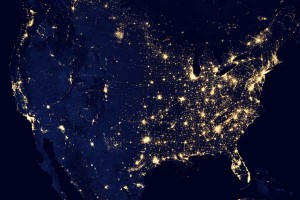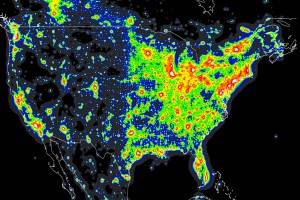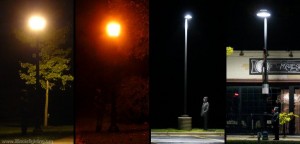 |
 |
| Artificial Lighting Visible from Space – 2012 |
Sky Brightening Resulting from Artificial Lighting |
| NPP Suomi VIIRS Photo courtesy of NASA Earth Observatory image by Robert Simmon. | Image credit: P. Cinzano, F. Falchi, C.D. Elvidge. © Royal Astronomical Society. Reproduced from the Monthly Notices of the RAS by permission of Blackwell Science. See The Night Sky in the World. |
What Is Light Pollution?
Light pollution is artificial light introduced into the natural night, especially where it is not needed or wanted. This unwanted light appears
- In the sky, causing sky glow, obscuring the stars and creating perpetual twilight
- Shining into your yard or through your windows into your house, causing “light trespass”
- Shining into your eyes, causing glare
That light can cause pollution is a new idea for most people, and many may think it is not really very important except to astronomers. But light pollution interferes with living systems in many ways, causing, for example, sea turtles to lose their way to the sea, migrating birds to become confused and strike buildings, and plant seasonal cycles to be disturbed. It also affects human hormone cycles and our day-and-night cycles of sleep and wakefulness. Using light carelessly wastes energy, resources used to make the energy, and interferes with everyone’s visibility not only of stars but also of things on the ground that we need to see.
Stray light, in the sky or elsewhere, is wasted light – it is not needed for and does not help visibility. It is really a mistake that it is there. Why does it happen?
Wasted light happens mostly because people don’t think about outdoor lighting and the night.
Light fixtures that are poorly designed waste light by letting it shine upward or to the side, dramatically and unnecessarily increasing sky glow, light trespass, and glare. These fixtures are everywhere, at homes and businesses, and even in Flagstaff, which is more careful than most communities.
Why Does It Matter?
Though astronomers need naturally dark skies to see and learn about faint and distant objects in the Universe, dark skies are valuable for everyone – they have been a source of beauty and inspiration to all of Humankind for as long as people have been aware enough to raise their eyes from the ground and wonder. And light that provides visibility without waste or glare is vital for vision for everyone.
Unfortunately, research is showing that in the U.S.A. fully two-thirds of us live under skies so bright we have lost the view of the Milky Way. And this loss comes mostly from just plain bad lighting – lighting that is not even doing a good job of showing us things we need or want to see on the ground.
Doesn’t more light make us safer?
The tendency is for people to say that they feel safer in brightly lit areas, but statistics do not indicate that most crime-plagued areas are made safer by increased lighting. Studies are mixed but there are results indicating increased crime with increased lighting. This may be the result of people feeling safer when they actually aren’t, thus being lulled into taking fewer anti-crime precautions.
Photo courtesy of Illinois Coalition for Responsible Outdoor Lighting
There is a person underneath each of these lights. In the two pictures on the left the person can see you but can you see the person? Are you really safer with more light or is it merely an illusion? Fully shielded light fixtures give you and the other person the same advantage, and minimize trespass and sky glow.

